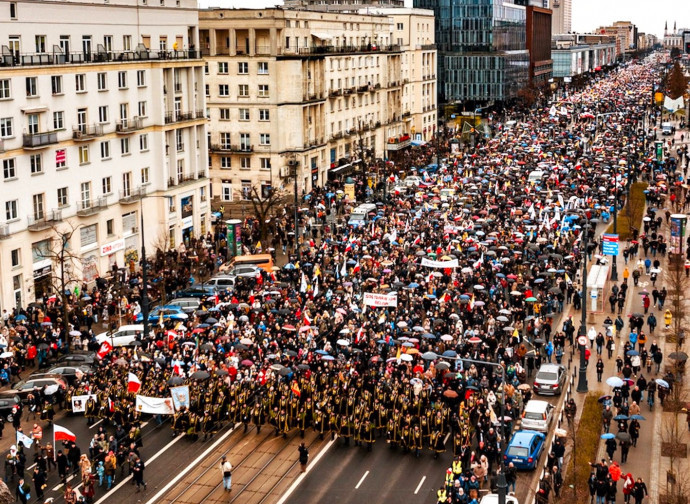Poles take to the streets to defend Pope Wojtyla
The media campaign aimed at vilifying St John Paul II has been followed by acts of vandalism on monuments depicting him. But the people do not take kindly to this and defy bad weather and lies in order to thwart yet another attack on the memory of the holy pontiff.

It was all well organised and calculated: first a concentrated attack by a veritable media coalition composed of the daily newspaper Gazeta Wyborcza, the weekly Newsweek Polonia, TVN television and the Onet portal to besmirch the figure of John Paul II and provoke, often organised, a public reaction (written about here in the Daily Compass); then a media campaign to "publicise" internationally the acts of desecration of the monuments to Pope Wojtyla. For years certain circles in Poland, but also in other parts of the world (see Brussels and Berlin) have been working to 'normalise' Poland, to secularise it, to detach it from its Christian roots, from its national identity, to weaken it by dividing Polish society. Everything that happened on the eve of the anniversary of John Paul II's death was proof of this.
On the night of 1 to 2 April, the statue of John Paul II in front of Lodz Cathedral was daubed with paint and the words 'Maxima culpa' (the title of the book with the accusations against Pope Wojtyla) appeared on the pedestal. The photo, as expected and well calculated, circulated the globe for maximum visualisation. The Archbishop of Lodz Msgr Grzegorz Rys was in front of the monument as early as 7am: for an hour he prayed and recited the Rosary and the Divine Mercy Chaplet. "When you look at this monument, you can see that it was not an emotional, spontaneous action, a reflex. No, it is clearly a planned action; someone had created a stencil so that the inscriptions on this monument would be clear. The painted stains are 'planned': blood on the hands, a yellow mask on the face” the metropolitan remarked. Msgr Rys wondered what John Paul II himself would have done in his place. He thought he would surely have prayed, and he remembered the Holy Father's words spoken on 17 May 1981, four days after the attempt on his life: “I pray for the brother who struck me, whom I have sincerely forgiven. United with Christ, Priest and Victim, I offer my sufferings for the Church and the world”.
The serious incident in Lodz, predictably, was followed by others: even the statue of the Pope in Stalowa Wola was soiled with paint, while in Wroclaw (Breslau) a mural of the Pontiff was defaced. Liberal-libertine left circles believed that the attack on St John Paul II had been so well prepared that Catholics would be overwhelmed by this final, devastating blow. But, again, they miscalculated: the majority of people of upright conscience and sound thinking did not take the bait. For them, John Paul II is a holy man: that is how he is in their hearts, that is how he will remain. This majority, which in a few days became a true social, national movement, demonstrated in Polish towns and villages on the anniversary of the Pope's death, Palm Sunday.
Ignoring the bad weather, the freezing cold and rain, people took to the streets driven to defend the truth: the truth about the Polish Pope against the manipulation and lies being spread. Hundreds of thousands of people took part in the Pontifical Marches (opposite, above, and below in photos by Krzysztof Staszewski): the largest event was organised in Warsaw, tens of thousands of people (even estimates of 50 thousand) turned out in the centre of the capital; in Krakow there were 20 thousand people; in Szczecin 10 thousand; in Rzeszow and Gdansk 4 thousand. The organisers of the marches emphasised that the demonstrations were intended to be a testimony of attachment to St John Paul II and, at the same time, also a response to attempts to challenge the sanctity and merits of the Polish Pope. "By participating in the March, we thank the great Pole, John Paul II, for his legacy of love and faith left to the next generations" - the organisers wrote. One of them, Małgorzata Żaryn, emphasised that the papal march was meant to be an expression of unity, not an element of division: "We want to give back to our community the person and teaching of the Polish Pope and, at the same time, recreate our community thanks to who he was".
Participants in the various demonstrations carried crosses, national and Vatican flags, and many portraits of Saint John Paul II. Black cassocks with the Polish Pope's coat of arms of the Order of the Knights of St John Paul II were a common sight. Masses were celebrated at the end of the marches: in Warsaw, Mass was celebrated in the Polish capital's cathedral by Archbishop Jozef Michalik, Archbishop Emeritus of Przemysl.
The reaction of Polish society seems to have thwarted this umpteenth attack against Saint John Paul II, at least for now. But let us not be deluded, it won’t be the last. Because John Paul II, such a holy man, will always remain a sign of contradiction for our anti-Christian 'modernity'.




